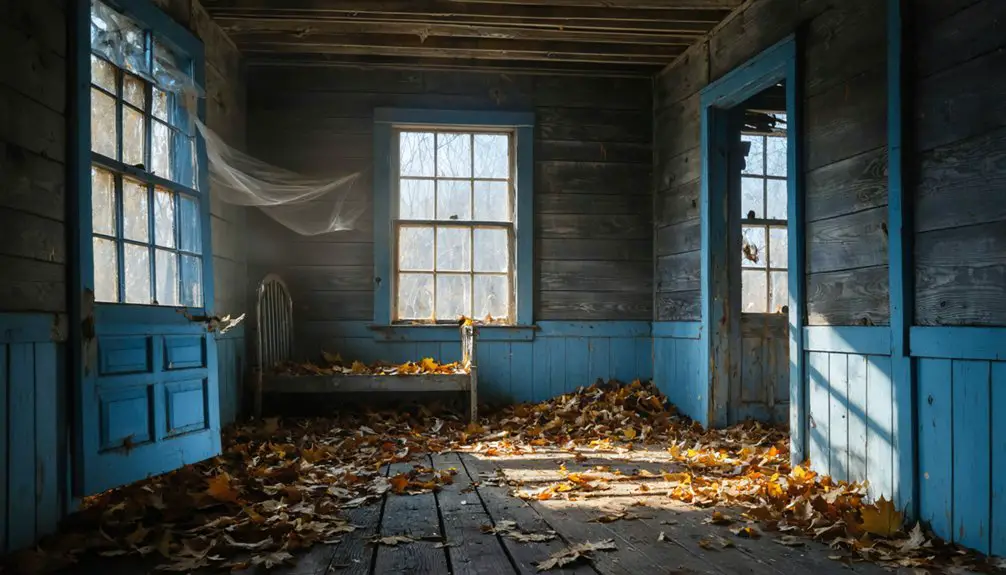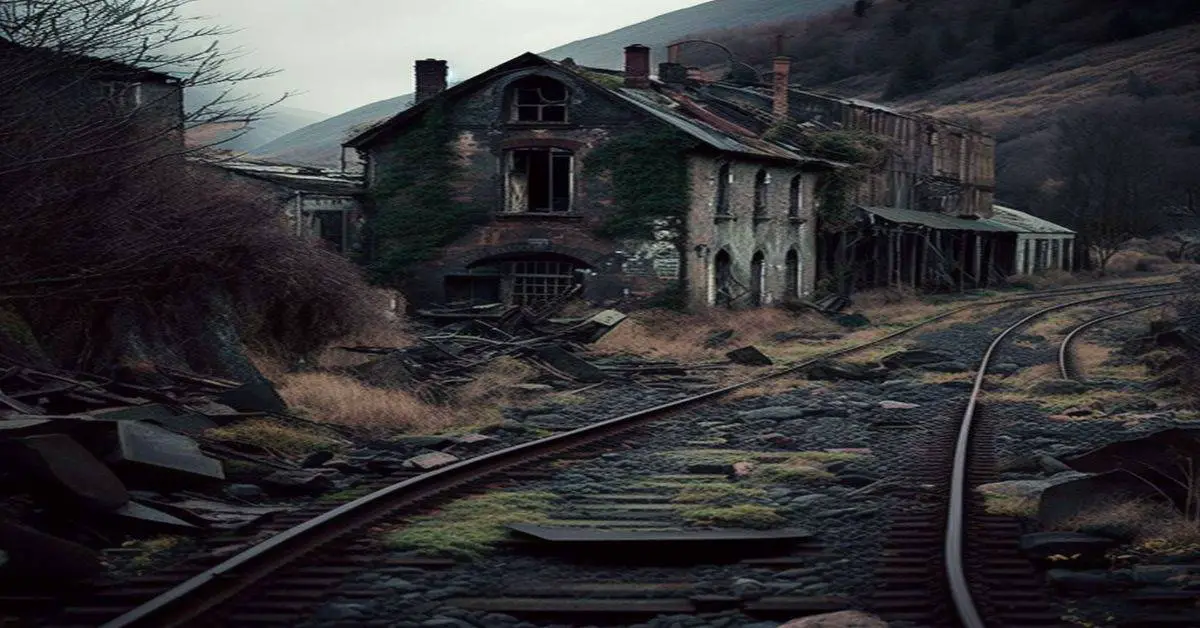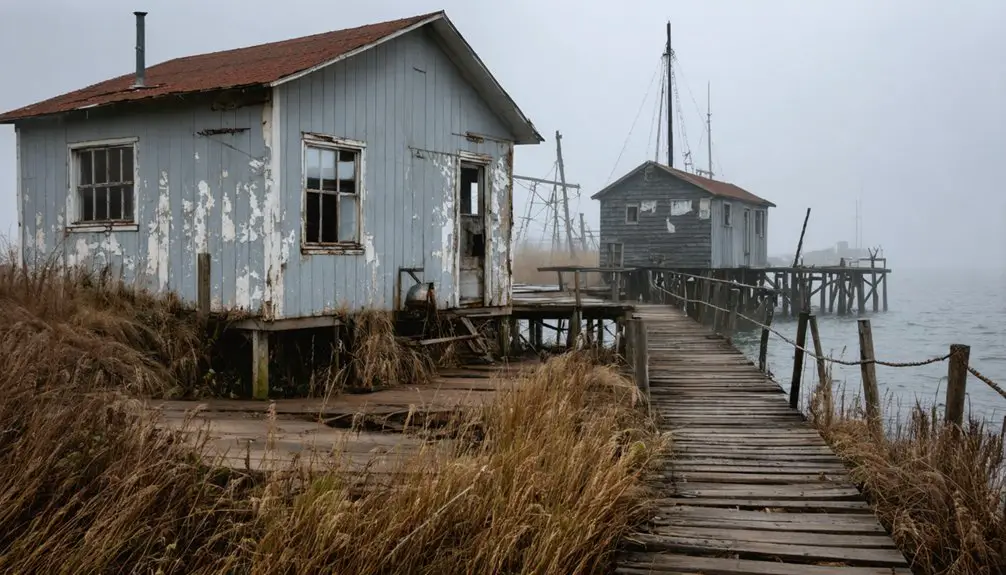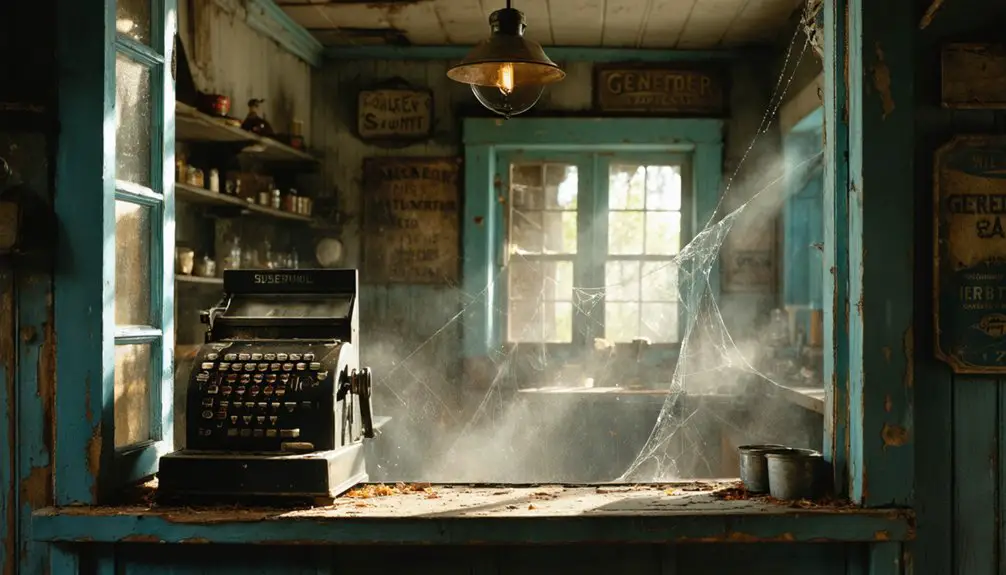You’ll discover Harrison’s evolution from an 1870s logging boomtown to a northern Wisconsin ghost town, where Belgian and Dutch immigrants later established farming settlements after pine forests were depleted. The community’s Catholic churches became cultural anchors, while Prohibition-era bootlegging operations, including ties to Al Capone’s syndicate, added intrigue to its legacy. Today, walking trails and historic remnants reveal fascinating layers of this lost community’s past.
Key Takeaways
- Harrison transformed from a thriving logging settlement to a ghost town after the depletion of pine forests in northern Wisconsin.
- The town’s decline began in the 1880s when extensive logging operations exhausted the valuable white pine resources.
- Only the church cemetery remains as a physical testament to Harrison’s past as a once-vibrant logging and farming community.
- The area’s bootlegging operations during Prohibition, including an illegal distillery, briefly sustained activity before final abandonment.
- Modern recreational trails now wind through Harrison’s former settlement, preserving the ghost town’s historical significance for outdoor enthusiasts.
A Lost Community Emerges
While northern Wisconsin’s vast pine forests attracted many logging settlements in the 1870s, Harrison emerged as a distinctive community that would experience both rapid growth and eventual decline.
Harrison stands out among Wisconsin’s 1870s logging settlements as a unique community shaped by cycles of prosperity and downturn.
You’ll find Harrison’s logging history began with ambitious lumbermen who harvested the region’s abundant white pine, establishing the town’s initial economic foundation.
As the pine forests depleted, you’d witness remarkable community resilience as Harrison transformed from a logging outpost to a farming settlement.
Father Charles Hoogstoel played an essential role in this change, actively recruiting Dutch and Belgian immigrants who were keen for new land opportunities.
These European settlers brought their agricultural expertise and strong Catholic faith, establishing farms and building a close-knit community anchored by a church and school between Stockbridge and Sherwood.
Today, the area stands as a notable ghost town, serving as a reminder of Wisconsin’s dynamic historical transitions.
Immigrant Dreams and Settlement
You’ll find that Harrison’s story truly begins with Belgian and Dutch immigrants who arrived in the early 1900s, drawn by Father Charles Hoogstoel’s promises of fertile land and new opportunities.
Much like the European settlers before them who came seeking prosperity in the fur trade, these new immigrants sought their fortunes in Wisconsin’s rich landscapes.
After the white pine depletion, the immigrants eagerly purchased the cleared land for their farming endeavors.
Your ancestors established a devout Catholic community, with their faith serving as the bedrock of their new American identity.
The immigrants’ dreams of owning farmland materialized as they transformed Harrison’s post-logging landscape into productive agricultural plots, marking their permanent stake in Wisconsin’s frontier.
Belgian-Dutch Settlers Arrive
After the initial wave of lumbermen depleted Harrison’s pine forests, Belgian and Dutch immigrants arrived in the mid-19th century seeking affordable farmland and better economic opportunities.
Under the guidance of Father Charles Hoogstoel, who actively promoted and sold land, these newcomers established tight-knit communities centered around their cultural heritage and faith.
You’d have found the Walloon-speaking Belgians bringing their distinctive traditions, including red brick architecture with bull’s-eye windows and roadside votive chapels.
The Dutch settlers, both Catholic and Protestant, organized under clerical leadership to develop farms, sawmills, and artisan trades.
Their settlement patterns reflected strong ethnic clustering, with communities forming around churches and shared cultural practices, similar to how Dutch East India exploration had shaped early American settlements.
Together, they transformed Harrison’s landscape from bare forestland into thriving agricultural settlements, though they’d face numerous challenges like storms, fires, and isolation along the way.
The settlers established communities with distinct Belgian place names like Brussels and Namur, preserving their cultural identity in their new homeland.
Faith Guides New Home
As Belgian and Dutch immigrants sought new beginnings in Harrison, their Catholic faith served as both compass and anchor in establishing their frontier community. Under Father Charles Hoogstoel‘s guidance, they secured land and built homesteads while maintaining their cherished faith traditions.
You’ll find their church became more than a place of worship – it was the heart of their social and cultural life.
The settlers’ deep religious convictions fostered community resilience amid the challenges of frontier farming. They’d gather for festivals that echoed their homeland customs, finding strength in shared beliefs and mutual support.
Through their Catholic parishes, they established educational programs, organized social networks, and preserved their cultural identity. This faith-centered foundation helped transform Harrison into a stable, albeit temporary, settlement in Wisconsin’s evolving landscape.
Farming Dreams Take Root
When Harrison’s white pine forests dwindled in the late 19th century, enterprising European immigrants transformed the logging town into a thriving agricultural settlement.
You’d have seen Dutch and Belgian families, recruited by Father Charles Hoogstoel, establishing roots alongside German settlers from Brandenburg and Pomerania. These newcomers purchased cleared timberland through Milwaukee firms and settlement agents like Andrew Kreutzer. Much like the New England pioneers who settled the Rock River Valley decades earlier, they sought fertile land for farming.
Your immigrant ancestors adapted their European farming techniques to Wisconsin’s unique environment, creating sustainable family farms that balanced crops and livestock. Like other immigrant groups across Wisconsin, they formed close-knit ethnic enclaves to preserve their cultural traditions.
Through cooperative labor and strong community ties, they built churches and social organizations that anchored their new lives. Their immigrant aspirations of land ownership and prosperity helped stabilize Harrison’s economy, shifting it from lumber dependency to agricultural strength during the 1880s and 1890s.
From Logging to Farming
You’ll find that Harrison’s early prosperity centered on its vast white pine forests, which drew waves of European lumbermen seeking to exploit this valuable natural resource.
These laborers earned 12 to 22 cents per hour working grueling twelve-hour days in dangerous conditions.
Skilled workers called river drivers managed massive log flows along waterways during the annual spring drives.
As logging operations stripped the land bare by the early 20th century, leaving countless stubborn stumps in their wake, the town’s economic foundation crumbled.
The subsequent shift to farming proved challenging for immigrant settlers, who struggled with poor soil conditions and the labor-intensive task of clearing stump-riddled fields using mechanical pullers and dynamite.
Pine Forest Prosperity
During the mid-1800s, Harrison’s pine forests attracted New England businessmen who established small logging camps and mills throughout northern Wisconsin.
You’d find crews of trimmers, sawyers, teamsters, and river drivers working tirelessly to harvest the region’s abundant white and Norway pines.
The Wisconsin River served as a crucial highway for transporting logs to the mills, powering the logging industry’s rapid expansion.
For about 62 years, you could witness the prosperity brought by pine forest harvesting, but this boom wouldn’t last forever.
By the 1880s, extensive logging led to widespread pine forest decline, leaving behind cut-over lands dotted with stumps and debris.
The shift from river drives to railroad logging marked the industry’s evolution, but ultimately couldn’t prevent the depletion of Harrison’s once-mighty pine forests.
Winter operations were essential as frozen ground made moving heavy logs much easier.
Agricultural Economic Shift
As the pine forests dwindled in the 1880s, logging companies and local governments urgently promoted Harrison’s cut-over lands to immigrant farmers, particularly Dutch and Belgian settlers.
You’d have seen Father Charles Hoogstoel actively recruiting families to establish homesteads, transforming the former logging town into an agricultural community.
The economic adaptation wasn’t easy.
You’d have faced significant agricultural challenges: clearing stubborn pine stumps, working with poor soil, and adapting to northern Wisconsin’s harsh conditions.
While southern regions thrived with wheat production, Harrison’s farmers had to diversify their crops and supplement their income through small-scale industries.
Despite these obstacles, the tight-knit Catholic farming community persevered, establishing a new economic foundation that included local mills and, during Prohibition, even some unofficial enterprises.
The Bootlegging Legacy
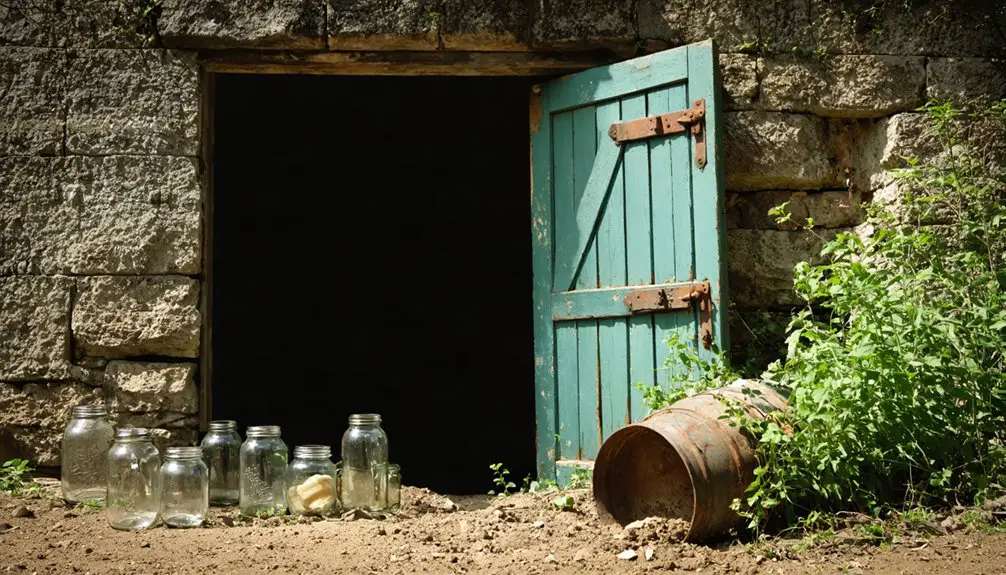
While the lumber industry declined in Harrison, Wisconsin, a more lucrative enterprise emerged: bootlegging.
You’d find a massive illegal distillery operating on 160 acres of fallow farmland, supplying bootleg liquor to Chicago, Milwaukee, and Minneapolis during Prohibition. Al Capone‘s organized crime syndicate recognized Harrison’s strategic value, establishing a significant production hub that caught the attention of law enforcement nationwide.
The bootlegging operations transformed Harrison’s economy, offering residents new opportunities as the logging industry faded.
Federal agents, alongside county and local police, eventually launched high-profile raids that made national headlines. Despite the crackdowns, the legacy of Harrison’s role in Midwestern bootlegging remains a demonstration of the community’s adaptability during Prohibition, marking a pivotal chapter in the town’s evolution from logging to illicit enterprise.
Traces of Yesterday
The physical remnants of Harrison tell a sparse but poignant story today. If you’re searching for the once-vibrant logging and farming community, you’ll find only the church cemetery standing as a solitary witness to the past.
Historical preservation efforts now rely heavily on photographs, newspapers, and oral histories collected from descendants of the original Dutch and Belgian settlers.
You can still detect subtle traces of community identity in the landscape where this close-knit village once thrived. Local historical societies work to maintain these connections through archival documentation, while families of early residents keep their ancestors’ stories alive.
The transformation from bustling immigrant settlement to ghost town mirrors countless other Midwestern communities that couldn’t survive the shifting economic tides of the 20th century.
Ghost Town Recreation Today
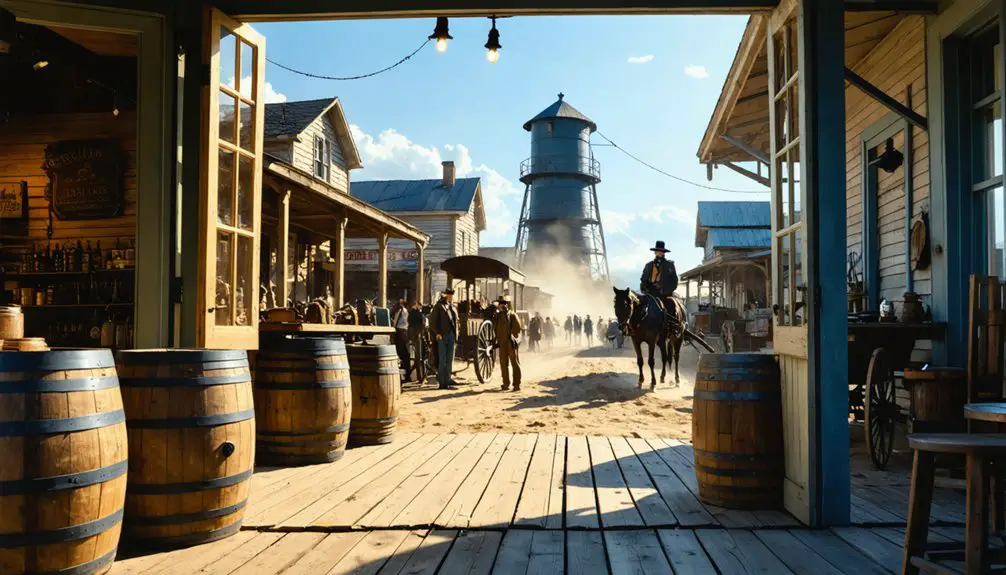
Modern outdoor enthusiasts have transformed Harrison’s quiet landscape into a vibrant recreational destination. You’ll find some of Wisconsin’s most beautiful recreational trails here, perfect for year-round adventures on UTVs, ATVs, and snowmobiles.
While exploring, you can still connect with the area’s past through the preserved Catholic church cemetery, offering opportunities for historical engagement.
Harrison’s Catholic cemetery stands as a timeless bridge to the past, inviting visitors to explore local heritage while enjoying modern recreation.
To make the most of your visit:
- Ride the extensive trail network that connects to broader Wisconsin routes
- Visit during winter for expertly groomed snowmobile paths
- Support local businesses in nearby towns that offer equipment rentals
- Participate in community events like trail races and meetups
You’re free to explore this recreational haven where conservation efforts protect both natural habitats and historical sites, ensuring future generations can enjoy Harrison’s evolving legacy.
Frequently Asked Questions
Are There Any Documented Paranormal Activities or Ghost Sightings in Harrison?
You won’t find any documented ghost stories or supernatural encounters in Harrison – historical records show no paranormal activity. The only unusual phenomena reported nearby are Sasquatch sightings in the valley.
What Happened to the Original Church Building That Served the Community?
Like footprints in sand, the original church’s fate was swept away by time. You won’t find the building today – it vanished during the community’s decline, leaving only the cemetery behind.
How Many People Lived in Harrison During Its Peak Population?
You won’t find exact peak settler numbers since there aren’t formal records, but based on typical rural church-centered demographics of that era, Harrison’s population likely reached several dozen to low hundreds.
Did Any Notable Historical Figures Visit Harrison During Its Active Years?
Poring through proper papers and historical records, you won’t find any notable historical visitors or prominent figures who came to Harrison. Local clergy, like Rev. John Adt, were the only documented leaders.
What Specific Crops Were Predominantly Grown by Harrison’s Farming Families?
You’ll find wheat dominated early crop diversity, with farmers later shifting to experimental crops like hops, flax, and sorghum. Their farming techniques adapted as soil depletion forced changes to potatoes and feed crops.
References
- https://en.wikipedia.org/wiki/Harrison_(ghost_town)
- https://theharrisonhistory.com
- https://www.youtube.com/watch?v=x4NEj7D0r8c
- https://www.geotab.com/ghost-towns/
- https://en.wikipedia.org/wiki/List_of_ghost_towns_in_Wisconsin
- https://kids.kiddle.co/Harrison_(ghost_town)
- https://www.wikiwand.com/en/articles/Harrison_(ghost_town)
- https://tile.loc.gov/storage-services/service/gdc/lhbum/7689c/7689c_0378_0431.pdf
- https://www.simpsonstreetfreepress.org/history/Origins-of-Wisconsin
- https://www.littlechutewi.org/DocumentView.asp?DID=200
